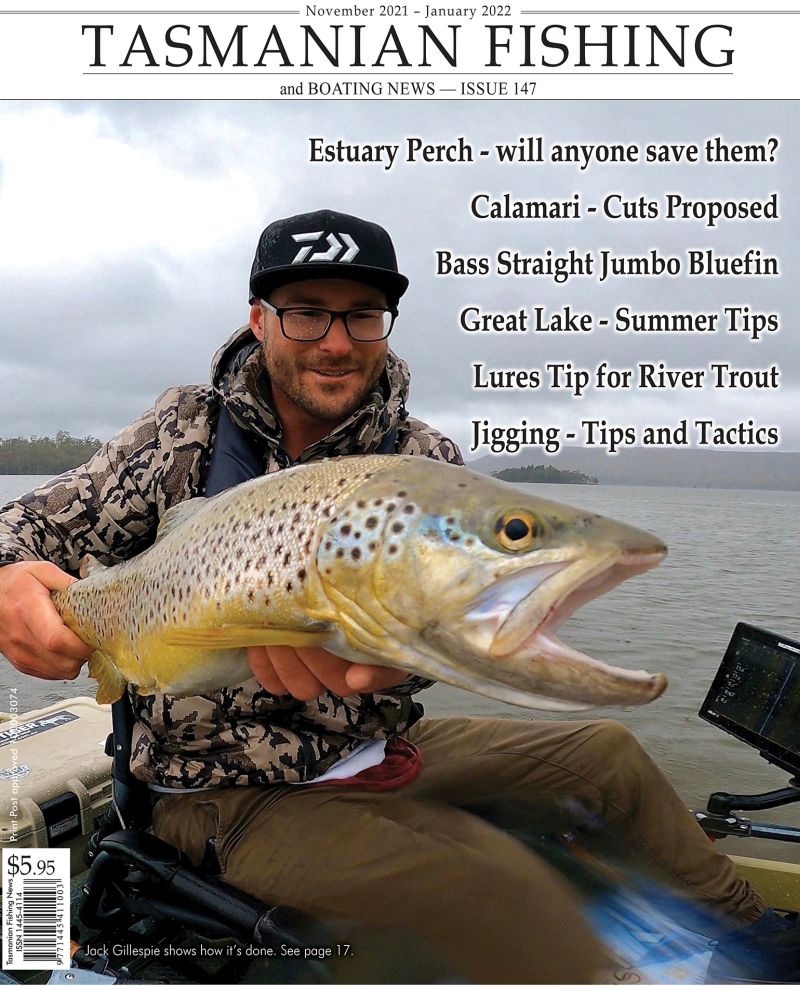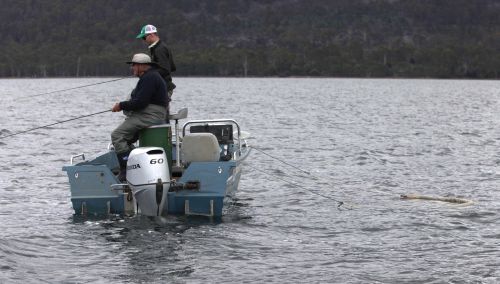Some great early season locations
Shane Flude
Well it's that time of year again, the opening of the brown trout season, time to check your old gear and stock up on some new. Now the only problem is deciding which location to hear for.
Here is a list of places that may help to narrow down your choice for the first few months of the season.
1. Mersey River
The Mersey can offer reliable sea run trout fishing in the tidal reaches. Hot spots are the back river and Bell's Parade weir at Latrobe. Preferred local method is cast and retrieve at night on a freshly caught galaxia or tiddly. Spinning with minnow-style lures is popular during the day. Fly anglers should concentrate on whitebait and shrimp patterns with the incoming tide, the last two hours before high tide is best.
When the river is in flood, a condition that sees the end of sea trouting for a while, the flooded grassy areas upstream can produce nice bags of smallish riverfish for the patient worm angler.
2. Forth
The Forth is more heavily regulated for Hydro than the Mersey and as such does not suffer the same sudden flood conditions. Sea trout fishing using all methods can produce well from opening day. The area between the Bass Highway and the Forth River weir being the most popular locations with easy access to many shores.
Locals have now secured many large fish in recent years by using sandies or roach set on the bottom. As the whitebait move up the estuary they start to congregate below the weir, making this a real hot spot in the river.
It takes several months for the whitebait to make their way upstream before they are blocked by their last obstacle on the river, the Paloona Dam. It pays to monitor this location closely and start fishing when the bait arrives.
3. Lake Barrington
Although open all year round, Barrington offers a reliable early season water, particularly for boat anglers. With deep clear shores and ever-calm water, Barrington is a perfect spot to try out new trolling techniques and give the boat a run after the winter break.
It offers the chance of catching reasonable numbers of browns, rainbows and atlantic salmon to all fishing methods.
When levels are high or with the lake filling, the grassy edges and bays at the lake Barrington Rowing Course are superb.
Any stirred up flooded shoreline is worthy of a cast with wet fly or a small minnow lure. Rapalas CD5 work well in the rainbow or brown trout patterns.
4. Cethana
Next lake upstream from Barrington, Lake Cethana is often overlooked by anglers. Shore fishing is basically restricted to several bays around the Lorinna area, but these are the most reliable and productive areas on the lake.
Again, high or rising water levels produce the best bags.
Fishing from a boat with wet fly or spinning with small rapalas around the flooded timbered shorelines near Lorinna produce great results.
Hot spots include the first creek mouth at Lorinna and for trolling enthusiasts the odd monster brownie has been pulled from the Dove River arm several kilometres upstream.
Locals have produced their biggest fish by set rod night fishing with small fresh blackfish.
5. Arthurs Lake
In the early months of the season Arthurs often produces well for all forms of bait anglers. As levels have remained quite low over the winter months excellent flood fishing may results if there are heavy spring rains.
Fishing soft plastics has become quite popular in Tasmania and Arthurs Lake has been a standout location for this method. The entrance to Jonah Bay and the morass area are prime spots.
Fish a Garry Glitter 65mm Squidgie on a three gram jig head in 20 feet of water and hang on.
6. Lake Echo
I have fished Lake Echo numerous times and consider it one of the best waters in the State. It fishes well using all methods from opening day and improves through the early months of the season. Levels have been very low for the past several years but this seems to have only increased the catch rate. The last few years has seen some enormous numbers of rainbows introduced; they have certainly improved the strike rate with some specimens now reaching four pounds.
The lower levels have drastically reduced the shore fishing options, so a boat on this lake is essential. The new boat ramp on the south western shore has increased access and boating numbers on Echo have increased. At 40 square kilometres however there is still a lot of water between patrons. Be warned, the waters on Echo can become very rough at little notice and extreme care should be taken when crossing the lake.
The preferred method by locals and author alike is trolling and spinning. The secret lure is the rapala CD7 in perch and brook trout patterns, but a stop/start method whilst spinning or trolling is imperative. If you find the fishing slow using rapalas it may be the trolling speed is to slow so speed up and compare the results.
The preferred locations are the north-western bays and timbered northern shores.
7. Great Lake
Despite a very cold winter and almost record low lake levels, Great Lake has fished extremely well all year and should continue to do so. With the exception of Canal Bay, Great Lake is open all year round however you may find you have the lake all to yourself during winter. On a recent trip the temperature was zero on arrival and reached a balmy two degrees - the water temperature was four degrees. I wore three layers of thermals and fleece, neoprene waders and a gortex hat and jacket.
The 12 trout up to 3 ½ pound I claimed on soft plastics from the Beehives certainly made up for the winter weather.
Spinning with rapalas from around the shores is a highly proven method, again with the cd7 size.(You have probably guessed by now that I just love rapalas.) Great Lake trout seem to prefer the minnow and hot mustard muddler patterns. These patterns do look similar to the native galaxia you will recover from the trout stomachs on these windy days. Seventeen from one male fish is my record. The rainbow trout pattern has also recently proven effective, perhaps due to the large numbers of small rainbows which have been stocked into the lake over the last few years.
The rainbow trout have thrived in Great Lake and are now up to 6 pound in weight, and are usually in superb condition.
Wet fly fishing the wave-swept shores with a smelt pattern that resembles the native galaxia can be very effective. A stripping basket is handy as the waves will wash the line around every second rock and when a three pounder grabs your fly you don't need any snags at your feet.
Preferred locations at Great Lake include any shore that is wind-swept and relatively deep. As Great Lake is predominantly affected by westerly and north-westerly weather I have found the most productive shorelines to be along the southern and south-eastern section. The entire headland of McLanahans Point can produce but a 4wd is needed to bounce your way out there. The southern-most corner of the old Arch Dam is always worth a couple of casts.
Do not be put off by the overly-muddy water, if the Rapala can still be seen in two feet of water you will still be in business and the fish seem to strike harder.
Regardless of which water you choose I'm sure most anglers will be keen to head out and wet a line somewhere to start the season.
Don't be deterred by freezing and foul early season weather as the initial months can provide some of the best trout fishing for the year. Just remember this is Tasmania so if you don't like the weather come back in ten minutes.
Shane Flude



